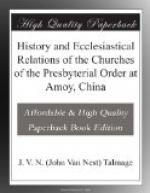“But it is not strange that such misconceptions should be spread in the Church. They are the necessary result of publishing certain remarks made in Synod concerning our paper, without publishing the paper itself.
“In the Report of the Synod, Synod’s Board, Board of Foreign Missions, it is said: ’It would have been well if the memorial had been placed, in a printed form, in the hands of the ministry. This they [the Missionaries] suggested, but the Board felt it was purely a Synodical matter—that they could not act in the case.’ With all due respect, and with the kindest feelings, we desire to make three remarks on this subject. First. We do not understand the principle on which the Board felt called upon to decide whether our letter should be published or not. It was not addressed to the Board, nor sent to the care of the Board. The opinion of members of the Board as individuals might have been asked, but we suppose that the Board in their official capacity had nothing to do with the paper. Secondly. Inasmuch as the paper emanated from us, if ‘it would have been well’ to have had it published, our suggestion was a sufficient warrant for its publication. The responsibility would have been ours. It had not yet become a Synodical matter. Afterwards it would have been a legitimate question for the Synod to decide whether they would entertain a paper coming before them in such a manner. This question might well have been left to General Synod. Thirdly. A short time previous to the writing of that paper, unless our memory is greatly at fault, a communication was received from the Arcot Mission (or Classis of Arcot), addressed to General Synod, which was thus published, according to the request of the Arcot brethren, and without the authority of Synod.
“Our position is a somewhat painful one. We desire to give offense to no one, and we do not wish to appear before the Church as disputants. We have no controversy with any. We have neither the time nor inclination for controversy. We are ‘doing a great work’ and cannot ‘come down.’ Yet, our duty to these Churches here, and to the Church at home, and to our Master, demands of us imperatively, that we state fully and frankly our views. We have the utmost confidence in our Church. We have proved this by endeavoring to get our views fully known. And we feel grateful for the spirit of kindness towards us manifested in the action of Synod, and also in the letters received from fathers and brethren in the ministry, notwithstanding




